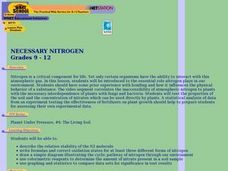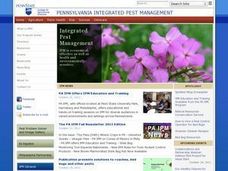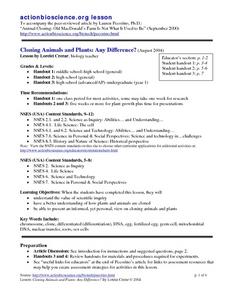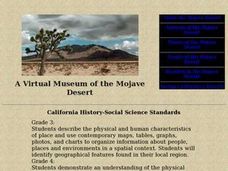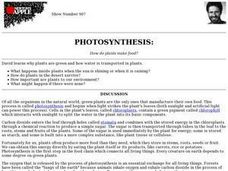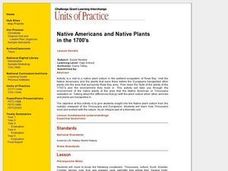Curated OER
Plants
Third graders study the factors necessary for plant growth and how plants adapt to their environment. They examine ow different plants require different environments to thrive.
Curated OER
Cells are 3-D!
Students design three dimensional models of plant and animal cells. They identify the cells parts, and compare animal and plant cells.
Curated OER
Plants and Animals of Great Bay Animals and Plants of the Estuary
Students participate in a webquest about the plants and animals that inhabit an estuary. They role play as environmentalists researching this habitat and present the results of their research in a creative way.
Curated OER
Marine & Aquatic Habitats Activities - Habitats of Birds, Fish, and Mammals on the Island and the Pacific Region
Students create habitats in jars to understand integral aspects of plants' and animals' habitats.
Curated OER
The Great Kapok Tree: A Social Studies Lesson
Students examine how plants, animals and people need each other in order to survive. They simulate an ecosystem in a food web and role play certain animals or plants. They answer questions about their simulation to finish the lesson plan.
Curated OER
See How They Grow: Plants And Their Parts
Students discuss what plants require in order to grow, identify plant parts and their functions and discuss a video about plants. They conduct a controlled experiment with bean seeds and then record and observe the bean plants.
Curated OER
Necessary Nitrogen
High schoolers view a video that presents the biogeochemical cycle of nitrogen. They compare types of soils and consider how different fertilizers affect soil composition.
Curated OER
Edible Plants
Students determine what part of a plant they are eating when they eat different fruits and vegetables, and make collages of fruit and vegetable pictures that are flowers, fruits, leaves, roots, seeds, seed pods, stems and tubers.
Curated OER
Weeds-Wild and Wonderful
Students compare and contrast weeds and desirable plants. They explore the ways which their ancestors used weeds and depended on them for food and other household necessities.
Curated OER
Cloning Animals and Plants: Any Difference?
Students examine the process in which plants and animals are cloned. They compare and contrast the two procedures and determine if there is a difference. They share their views on cloning to the class.
Curated OER
Flowering Plants
Pupils conduct online research to investigate gardening and landscaping tips. They determine how they can help beautify their homes and neighborhoods.
Curated OER
A Virtual Museum of the Mojave Desert
Learners study deserts and the plants, animals, and people who inhabit them. In groups, they create their own stories about the inhabitants of the Mojave desert.
Curated OER
Photosynthesis: How do plants make food?
Students study why plants are green and how water is transported in them. They examine how plants respond to different amounts of light.
Curated OER
Spring Nature Walk
Students go on a nature walk and look for specific plants and animals. They check off items they find and determine if they were a plant or an animal.
Curated OER
Give Me Back My School: A Back to Basics Approach to Ecological Restoration
Ninth graders research local geography to create successful, ecological school landscaping. They determine soil type, average weather patterns and temperature graphs and use the information to select ideal plants and plant maintenance...
Curated OER
Learning From Leaves: Adaptations To Differing Light Levels
Students, in groups, examine plants with different light levels. They are given plants from a tropical and desert region. They write a hypothesis at the beginning of the experiment.
Curated OER
Seasonal Scroll Painting
Learners take a field trip to a Botanical Gardens. They observe plants and the seasonal changes they go through and create their own scroll painting.
Curated OER
Native Americans and Native Plants
High schoolers take a field trip to a native plant culture. They need to describe where the plants were before the Europeans occupied North America.
Curated OER
Identify Plant Parts
Students use the word processor to write about the process they used to grow a plant. They import a graphic image of their plant into the document they have written, then proofread their document.
Curated OER
Unit on Developing a Basic Understanding of Plants
Fifth graders study the parts of a plant, their life cycles, and how to care for them in this unit.
Curated OER
How Are We Alike and Different?
Students review an online database and look for similarities and differences among the plants, animals, and non-living things that were listed. They compose a narrative based on their conclusions.
Curated OER
Field Trip to your Square
Students visit an outdoors area and mark out a square on the ground that they examine. They look for and record the plants, animals, and non-living things they find in the square and post their findings on the Internet for other classes...
Curated OER
What's Up at the Rim?
Students are sent on a scavenger hunt to find as many plants as they can in nature.
Alabama Learning Exchange
What do Plants Need?
Students plant seeds and watch them sprout. Once growing plants are placed in different conditions and students record data about their growth. They graph the data.








